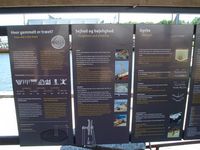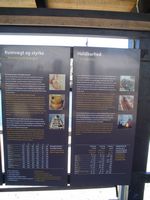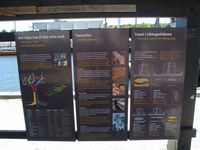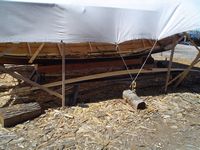
 How old is the tree?
How old is the tree?
For every year that a tree lives a new growth layer is added to the tree -- a year ring. The year rings can be either wide or narrow depending on climate
and soil conditions in the area where the tree grows. The various rings form a pattern that varies from area to area. Every area has its own growth conditions
and trees from the same area display similar patterns.
The drawing shows the principle behind year ring dating / dendrochronology.
The inner part of the year ring pattern in a younger, still living, tree matches the outer part of the pattern of an older logged tree. Thus the year ring patterns
form an overlapping series. By comparing to even older trees, that have been used as construction materials in, for example, churches, bridges or wells, is is possible to
trace the series even further back in time.
Toughness and pliability
The toughness of wood depends on how much it can be bent before it breaks. Tough wood can be bent a lot before it breaks. Trees with tough wood are hazel, birch, elm, willow, ash,
hornbeam and maple. Less tough wood is alder, spruce (fir), pine, larch, oak, and beech. The toughness of the wood grows in relation to the water content and green wood is therefore tougher
than dry wood. The longship is built from green wood.
The pliability of the lumber depends on how much force is necessary to bend it. The pliability of the lumber increases with the water content and this can be controlled by the boatbuilders through
a variety of methods. The lumber can be immersed in water, it can be steamed, or it can be heated over an open flame while being sprayed with water. When the water content of the lumber
is suitable it is clamped to the desired shape which it will retain after drying/cooling.
Strength
Lumber strength is defined by compression, tensile stress and deflection force coefficients. This is measured in kg/cm
2 and normally relates to density.
The higher the density of the lumber (i.e. the heavier the lumber), the stronger it is.
Compressive strength
The compressive strength of the lumber is how much force can be applied before the lumber breaks.
Tensile strength
The tensile strength of the lumber is how much one can pull at it before it breaks.
Deflective strength
The deflective strength of the lumber depends on how much it can be bent before it breaks.
Strength is affected by:
Water content - The greater the water content, the less strength.
Knots - The strength and workability of lumber is reduced by knots.
Workability - The lumber is strongest when its fibres have not been cut.
External factors - Fungi, bacteria, and insects destroy the lumber.
 Density and strength of different types of wood
Density and strength of different types of wood
Every woodworking tradition puts up its own particular demands as to the quality of the lumber. The carpenter wants wood which has a pleasing appearance,
is dry, easy to work, and sands smooth. A wood carver wants soft woods that are easy to work. The cooper needs straight lumber, easy to split, tough, pliable and odorless
for making good vats and barrels. A boatbuilder wants durable, strong, pliable and knot-free lumber. If the lumber is healthy then the right type of wood always be used for its proper purpose.
The difference between good and bad lumber of the same type can be very great. The strength properties of willow vary a lot from species to species. In the table below the strength of willow
is inferior to both oak and pine. In the experience of the boat builder, however, the goat willow is both tougher and more resistant to impacts than both pine and pine.
| Density and strength in different species of wood |
| Species | Density kg/m3 | Tensile strength kg/cm2 | Compression strength kg/cm2 | Deflection strength kg/m2 | Modulus of elasticity 1000 kg/cm2 | Hardness kg/m2 |
| Ash | 720 | 1100 | 430 | 1062 | 93 | 760 |
| Birch | 610 | 1470 | 530 | 1470 | 165 | 490 |
| Oak | 650 | 900 | 630 | 880 | 117 | 650 |
| Linden | 490 | 850 | 520 | 1060 | 74 | 330 |
| Willow | 520 | 680 | 340 | 370 | 72 | 330 |
| Black Alder | 530 | 880 | 470 | 850 | 77 | 440 |
| Pine | 490 | 1040 | 550 | 1000 | 120 | 350 |
| Norway Spruce | 430 | 900 | 500 | 780 | 110 | 270 |
| Larch | 550 | 1070 | 550 | 990 | 138 | 380 |
| Elm | 640 | 800 | 560 | 890 | 110 | 640 |
| Hornbeam | 790 | 1350 | 820 | 1600 | 162 | 890 |
| Beech | 680 | 1350 | 620 | 1230 | 160 | 780 |
Durability
The durability of the lumber depends on various factors, e.g. species, growth conditions, and how it is treated after logging. Fungi, rot, and insects attacks lumber and, over time, destroys
its strength. Some species of wood, like oak and pine, contain fungicidal chemicals like tannin and resin. An oak post, driven into the ground, will last from 50 to 100 years while a post
made from beech will only last 10 years. Beech, on the other hand, will last longer when stored under water.
The more moisture the lumber is exposed to, the greater the risk of fungus attacking the wood. The lumber can be protected with, for example, tar, oil, or paint. The boatbuilders treat the
wooden ships with wood-tar, which can make them last for up to 100 years. In the exhibition at the museum you can see how the tar is made.
The difference between good and bad lumber of the same type can be very great. The strength properties of willow vary a lot from species to species. In the table below the strength of willow
is inferior to both oak and pine. In the experience of the boat builder, however, the goat willow is both tougher and more resistant to impacts than both pine and pine.
| Durability of the wood species used in the construction of the Skuldelev ships |
| Species | Unprotected in the open air (years) | Under cover in the open air (years) | Indoor and dry (years) |
| Ash | 15 - 60 | 30 - 100 | 300 - 800 |
| Birch | 3 - 40 | 3 - 40 | 500 |
| Beech | 10 - 60 | 5 - 100 | 300 - 800 |
| Oak | 50 - 120 | 100 - 200 | 300 - 800 |
| Alder | 3 - 40 | 3 - 40 | 400 |
| Elm | 60 - 100 | 80 - 180 | 1500 |
| Larch | 40 - 90 | 90 - 150 | 1800 |
| Willow | 5 - 30 | 5 - 40 | 600 |
| Norway Spruce | 40 - 70 | 50 - 75 | 120 - 900 |
| Pine | 40 - 85 | 90 - 120 | 120 - 1000 |
 The right wood for the right place
The right wood for the right place
It is important to chose the lumber for the individual parts of the boat based on the natural shape of the tree -- for example, crooked growth lumber for the frames and beams.
In this manner the natural fiber arrangement of the lumber is preserved giving the viking ships their inner construction strength and stability.
| Lumber selection |
| Danish | English | Latin |
| Rødgran | Norway spruce | Picea abies |
| Sitkagran | Sitka Spruce | Picea sitchensis |
Douglas
Douglas fir do not exist in Europe at all. They are a North American/Asian species. Obviously, they are not period. | Douglas fir | Pseudotsuga menziesii |
| Lærk | Larch | Larix |
| Bøg | Beech | Fagus sylvatica |
| Eg | Oak (probably white) | Quercus (Unsure of what kind) |
| Ask | Ash | Fraxinus excelsior |
| (Skov-)Elm | Wych Elm | Ulmus glabra |
| Ahorn (Ær) | (Sycamore) Maple | Acer pseudoplatanus |
| Birk | Birch | Betula |
| Almindelig Avnbøg | Hornbeam | Carpinus betulus |
| Rød-El | Black Alder | Alnus glutinosa |
| Småbladet Lind | Small-leaved Linden | Tilia cordata |
| Skov-Fyr | Scots Pine | Pinus sylvestris |
Mahogni
Obviously not period... | Mahogany | Swietenia |
| Impossible to read | and I am tired trying to | figure out what it says... |
| Selje-Pil | Goat Willow | Salix caprea |
Species of wood
The selection of a particular species of tree is an exercise in prioritization of the many properties of the lumber such as strength, weight, durability, growth method and appearance.
The boatbuilder wants durable, strong, pliable, and knot-free lumber.
Lumber for boats
Many viking ships are constructed from oak which is stronger than, for example, birch. Birch, on the other hand, is stronger than oak.Fro this reason birch is used to manufatcure easily
accesible parts of the ship which can be quickly maintained with tar or replaced. Here durability is prioritized higher than strength.
Lumber for wooden nails
In many viking ships the wooden nails are made from goat willow, which is tougher than oak. However, it rots much faster. Toughness, in this case, is more important than durability.
Lumber for the keelson
The mast of the ship is placed in, and pushes upon, the keelson. Beech has higher compression strength than oak but even so most keelsons in viking ships are made from oak because it
is far more durable than beech. In this case, durability is prioritized higher than compression strength.
Lumber for the mast
The masts are usually made from some sort of pine which is elastic. However, pine is not as tough as birch but it is light and grows straight. The low weight and the straight growth are in this
case prioritized higher than durability.
 The wood in the viking ships
The wood in the viking ships
The drawings show which species of wood were used in the construction of the Skuldelev ships.
The original ships can be seen in the museum.
The recontructed ships can be seen in the museum harbor.
Skuldelev 1
Skuldelev 1 was a powerful, ocean-going cargo ship. Length: 16 m. Width: 4.8 m. Date: approx. 1030. Place of origin: Western Norway.
Skuldelev 2
Skuldelev 2 was an ocean-going warship. Length: 29.4 m. Width: 3.8 m. Date: approx. 1042. Place of origin: Dublin, Ireland.
Skuldelev 3
Skuldelev 3 was a small, elegant cargo and exploration ship. Length: 14 m. Width: 3.4 m. Date: approx. 1040. Place of origin: Denmark.
Skuldelev 5
This is probably wrong: Skuldelev 5 was a small, maneuverable warship. Length: 13.3 m. Width: 2.5 m. Date: approx. 1040. Place of origin: Denmark.
Skuldelev 6
Illegible, I forgot my book at work so I can't get the facts.

